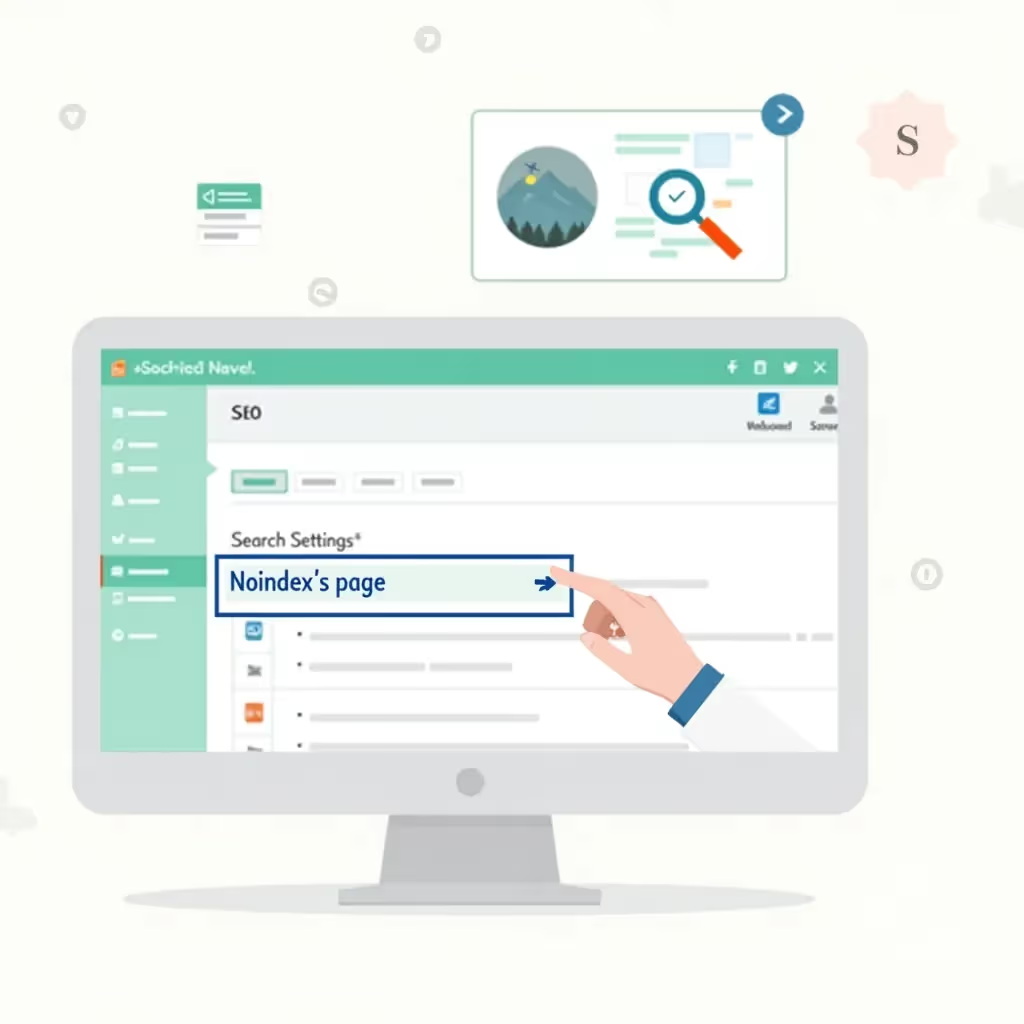Content marketing can be a fantastic strategy for B2B companies. Whether you’re selling software, a service, or physical goods, it can help you reach your buyers organically and at the right moments.
For companies with product-led growth (PLG) motions, content can build the top of the funnel and guide customers directly into your sales process. For companies with more enterprise sales motions, content can act as a sales enablement tool and nudge folks through the funnel.
Of course, there are many different types of content marketing. You’ve got SEO (search engine optimization) blog posts that target certain keywords, LinkedIn posts, podcasts, newsletters, and so much more.
As a content marketer, I’ve found that the different types of content marketing often work well together. For example, a sales prospect might discover you through a viral LinkedIn post that links to a recent blog post, which leads them to subscribe to your newsletter and then listen to your newest podcast.
The post you’re about to read is, in essence, content marketing for our company. In this post, we’ll explain why content is such a great strategy for B2B companies, highlight the different stages of the funnel, and show you 11 different approaches that you might want to consider (with examples for each).
Why Content Marketing Works for B2B Companies
Traditional sales channels — in particular, outbound sales — have become increasingly challenging over the years. It’s hard to stand out with a cold email, and don’t even get me started on email deliverability. According to Sales Insight Labs, 54% of sales reps report that getting in touch with prospects is much harder than it was five years ago.
While outbound marketing still works, inbound marketing, specifically content marketing, is often a better way to organically connect with potential buyers where they are. The best content helps communicate to potential customers that you and your company are experts in your field and that you understand the problems they’re experiencing. It also provides a pathway for customers to buy your product right now.
But don’t trust me, trust the data:
- 54% of B2B buyers spend more than one hour per week reading through leadership content.
- 52% of B2B buyers say that they are “definitely” more likely to buy from a vendor after consuming content from that vendor.
- According to a study by OG Marketing, Google Search is the No. 1 source of information for software buyers who are beginning their buying journey. Videos, blog posts, and podcasts are also critical sources of information during the buying process.
At Positional, nearly all of our customers come from our content marketing. We’ve got a fairly active blog, a weekly podcast, and a weekly newsletter that promotes all the content we create. Moreover, I stay fairly active on LinkedIn and Twitter, where I often repurpose the content that we’ve already created.
The Different Stages of the Funnel
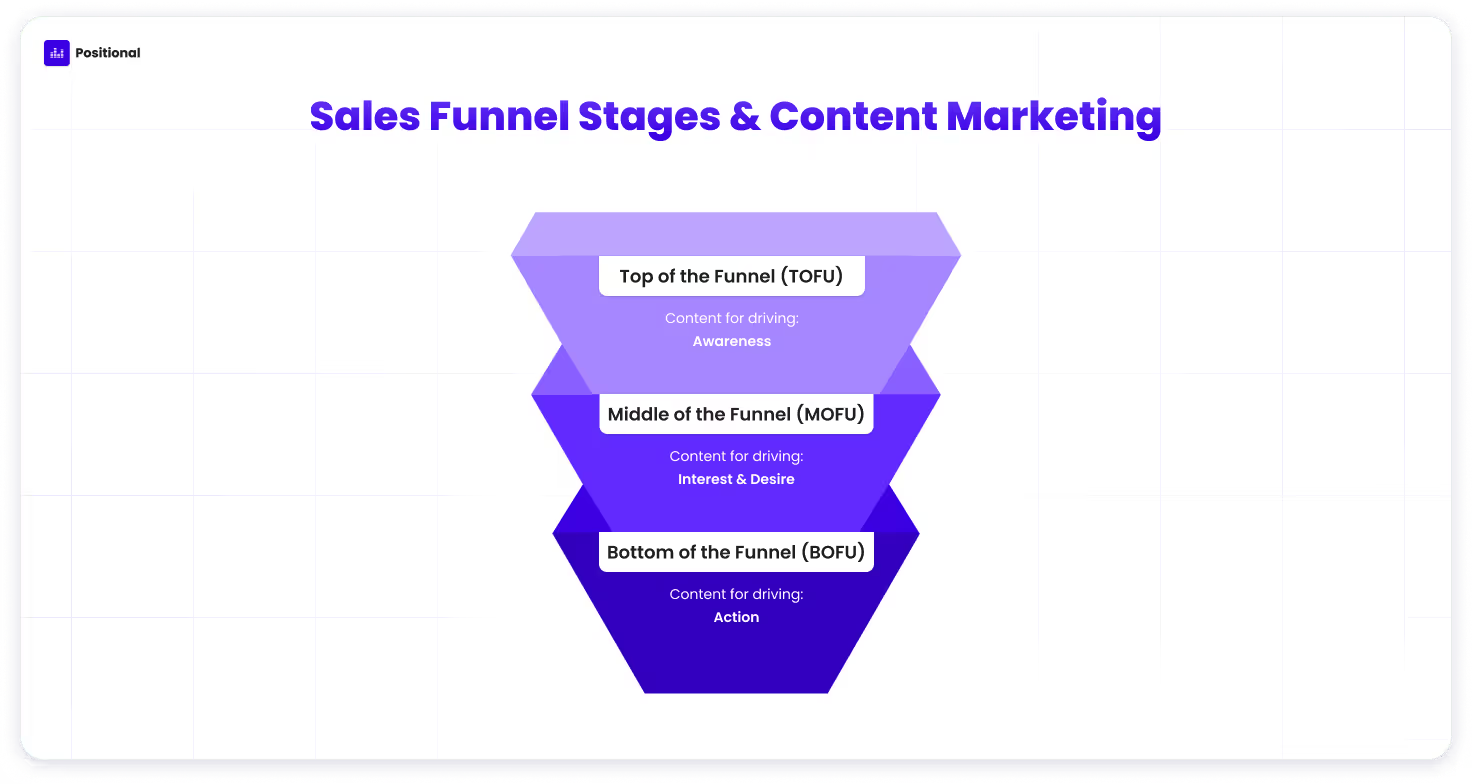
Before you start creating content, you’ll want to think about the different stages of the funnel.
You’ve got the top of the funnel, where potential buyers are just starting to learn about a problem space or topic area. For example, for the top of the funnel, you might create an evergreen “what is” blog post that explains the basics of a topic — for example, in Positional’s case, this would be a “What Is SEO?” blog post.
You’ve got the middle of the funnel, where a potential customer might be aware of the problem they need to solve and some of the available solutions
And then you’ve got the bottom of the funnel, where a prospect is ready to make a decision and make a purchase.
For the middle of the funnel, you might create a YouTube video that highlights a specific problem that a potential buyer might have — for example, Positional might create a video explaining how to properly implement internal links in a blog. For the bottom of the funnel, you might create a case study highlighting how your customers can implement your product and the core benefits of doing so.
While it might be tempting to focus only on the bottom of the funnel, which is where many companies start, the top and middle of the funnel are incredibly important for driving new sales prospects and introducing buyers to your universe.
11 Content Marketing Tactics to Try
There are so many different types of content marketing — here we highlight some of our favorites.
1. Blog Posts & SEO

I’ve spent most of the past ten years of my career creating blog content. Blog content is a fantastic place to start, as it allows you to target very specific keywords that people are searching for or topics that people want to learn more about.
Moreover, creating a lot of blog content opens up a number of opportunities for you to repurpose that content for use on other channels. So it can be a great jumping-off point.
As mentioned previously, many B2B buyers start their buying journey with search engines, predominantly Google. SEO is the process of identifying keywords, or search queries, and creating webpages to rank highly for those keywords in the organic section of search engine results pages (SERPs) such as Google’s.
You can use blog posts to target keywords across the different stages of the funnel. For example, on our blog, we are targeting keywords toward the bottom of the funnel with this piece of content about the best internal linking tools:
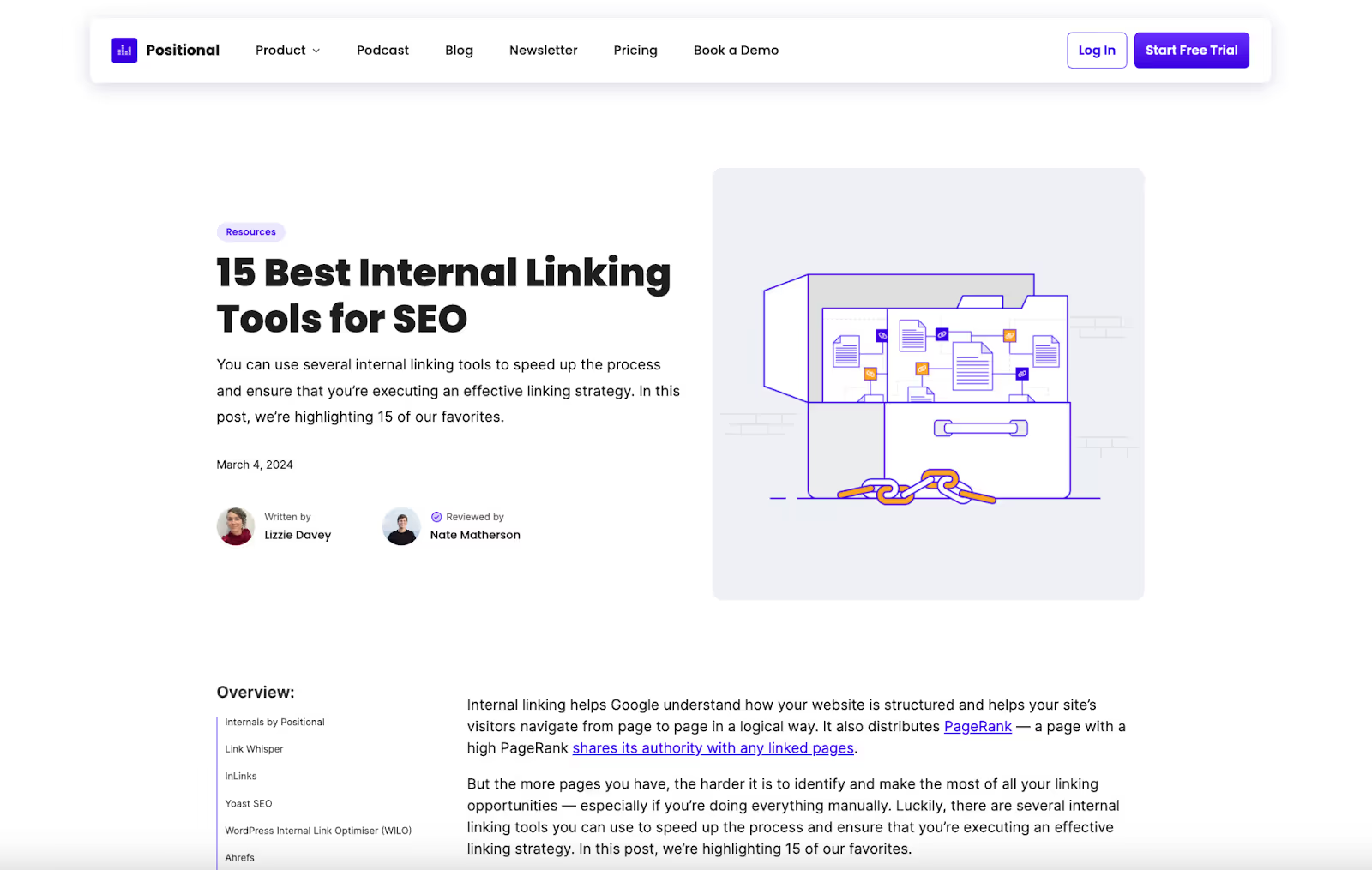
You’ll find that you can scale your blog pretty aggressively if there’s a lot to write about.
I recently chatted with Jeremy Galante, SEO Lead at ClickUp, who mentioned that they’ve scaled their content and SEO program to more than two million monthly visitors. Jeremy said that the team has published more than 100 pieces of content per month, which is amazing.
ClickUp targets broad keywords that are relevant to its potential customers, such as “kanban board.” It also targets very specific long-tail keywords toward the end of the funnel, like “best construction project management software,” and it is currently the top search result for this keyword.

The first step in setting up an SEO channel is to go through the process of keyword research. You’ll want to identify the primary keywords that you want your webpages to rank for, either by manually searching within a keyword research tool or by going through the process of competitor keyword research. Next, you’ll want to create helpful content aligned with those keywords or search questions.
However, not every blog post needs to be for SEO or targeted at a specific keyword. For example, you might want to create thought leadership content about a recent trend or news story. Or you might want to create a piece of content designed to perform well on a social media channel like Reddit or Hacker News.
Republishing Content
If you’re already creating helpful blog content for your site, you might be able to get extra mileage out of that content by republishing it to another platform, such as Medium or Dev.to.
These platforms can amplify your content’s reach and require little additional effort. If you go down the path of republishing your content to another platform, just make sure that you implement a canonical tag to let search engines know that your URL is the original source of the content.
2. LinkedIn

Did you know that 97% of B2B marketers use LinkedIn in their content marketing efforts — that is, according to LinkedIn?
I’ve been a lot more active on LinkedIn over this past year. It’s free (to post), and it works. In the past year, I’ve driven more than 700,000 impressions by posting regularly with engaging content:

LinkedIn, like SEO, can take some time to show results. But as you grow the number of followers that your company and personal accounts have, your impressions will increase.
I recently spoke with Kevin Jurovich about his process for creating viral content on LinkedIn. He shared some practical tips with me.
- Post on your personal accounts rather than your company accounts, as the LinkedIn algorithm will generally provide more impressions and reach.
- Post a few times per week with different types of content. You don’t want to post multiple times per day, but daily posting is OK if you have enough interesting things to say.
- Don’t overly promote your product or service. Instead, you want to grow your following and drive engagement — folks will naturally find your offering (for example, they may click from your personal profile over to your company page). Some promotion is OK, but most of your content should be about engagement.
- Make your personal and company profiles look professional. That means including high-quality images — for example, banner and profile images — and adding helpful context to your profile (such as a good description of who you are that explains why folks should trust you).
3. Building in Public
Another popular approach, especially with startups, is what is known as building in public — in other words, sharing day-in-the-life excerpts from inside the company.
James Hawkins, the founder of PostHog, will regularly share insights and experiences from his day-to-day work at the company. For example, here, James walks us through how PostHog approaches deciding what to build next:

You might share insights about go-to-market, business progress, hiring, and more. While it isn’t my only strategy, I’ll occasionally build in public, too. For example, in this post, I highlight the growth in traffic to our blog and explain the work that we are doing.
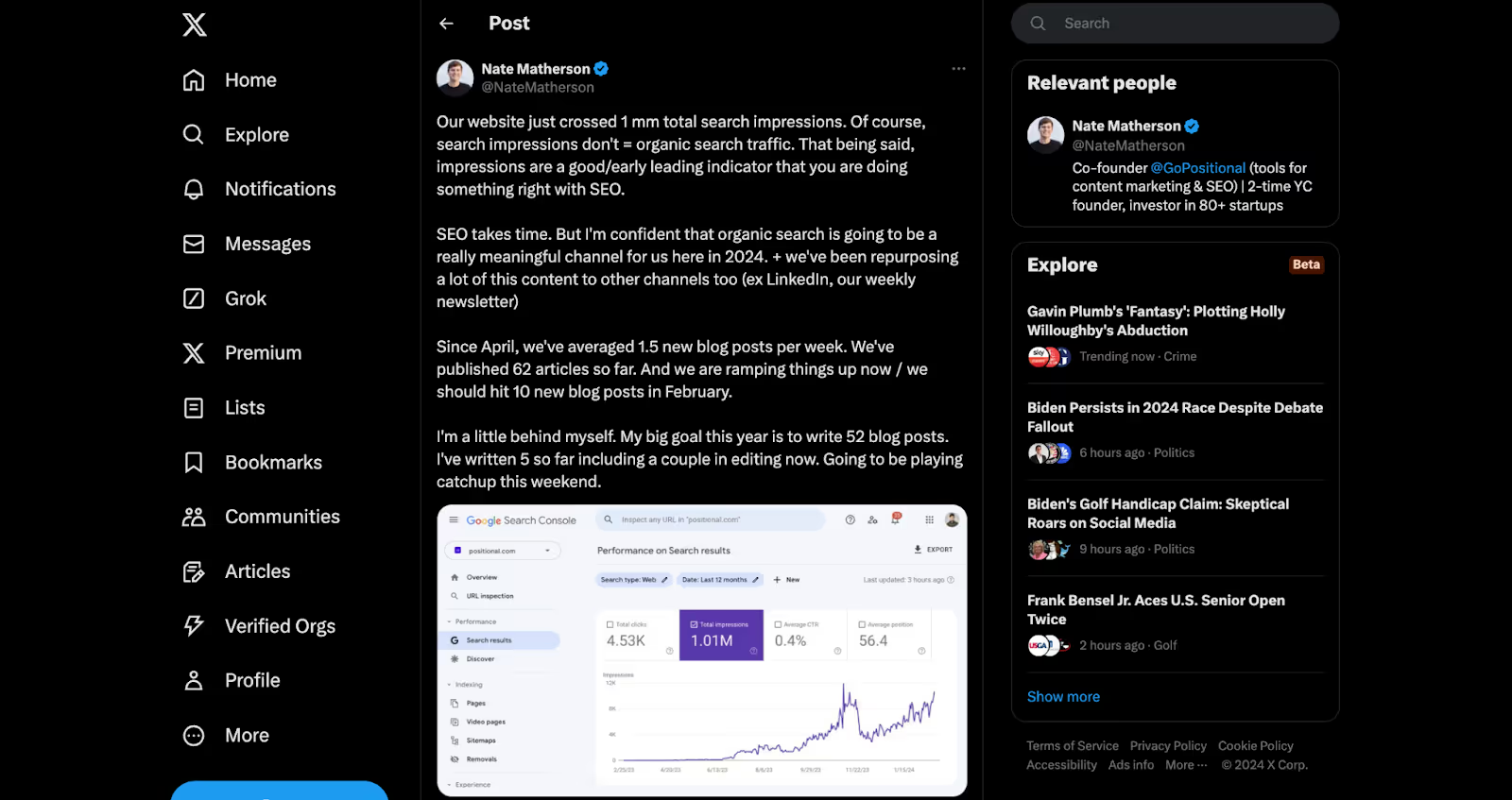
X (formerly Twitter) is by no means the only public building platform, but it is a popular one. And it’s totally fine to recycle content from one platform to another, for example, from X to LinkedIn.
4. Memes and Humor
X is a fantastic channel for shorter-form text, graphic, and video content.
I recently spoke with Chris Bakke, the founder of Laskie and previously the founder of Interviewed, about his experience leveraging X for content marketing.
Today, Chris has more than 200,000 followers on X. But he didn’t start there. Over the past few years, Chris’s posts have generated millions of views and engagements.
Given that Chris largely targets technology companies, a significant portion of his content is for this audience. Chris leverages humor and memes, often tapping into current events that are relevant within the technology industry:

While posts like the one above likely won’t drive direct conversions for your business today, they are important for building a large following and driving engagement with your personal brand.
When Chris was a guest on Positional’s Optimize podcast, I asked him about the conversion process or how you take someone from a humorous tweet to eventually buying your product. And he shared that the path is not always completely clear, but that eventually as the size of your following grows, people will naturally start to discover your company’s products and services, and that once in a while you can have more dedicated posts promoting your company.
5. Podcasting
Podcasting is an increasingly popular medium for content creation. According to Statista, almost 80% of the U.S. population is aware of podcasting, and by 2029, it’s projected that more than 110 million people will listen to podcasts.
While podcasts are great for B2C content marketing, they’re also very effective at reaching B2B buyers, especially for companies in industries that are actively changing.
Positional’s weekly podcast, Optimize, is published every Wednesday.
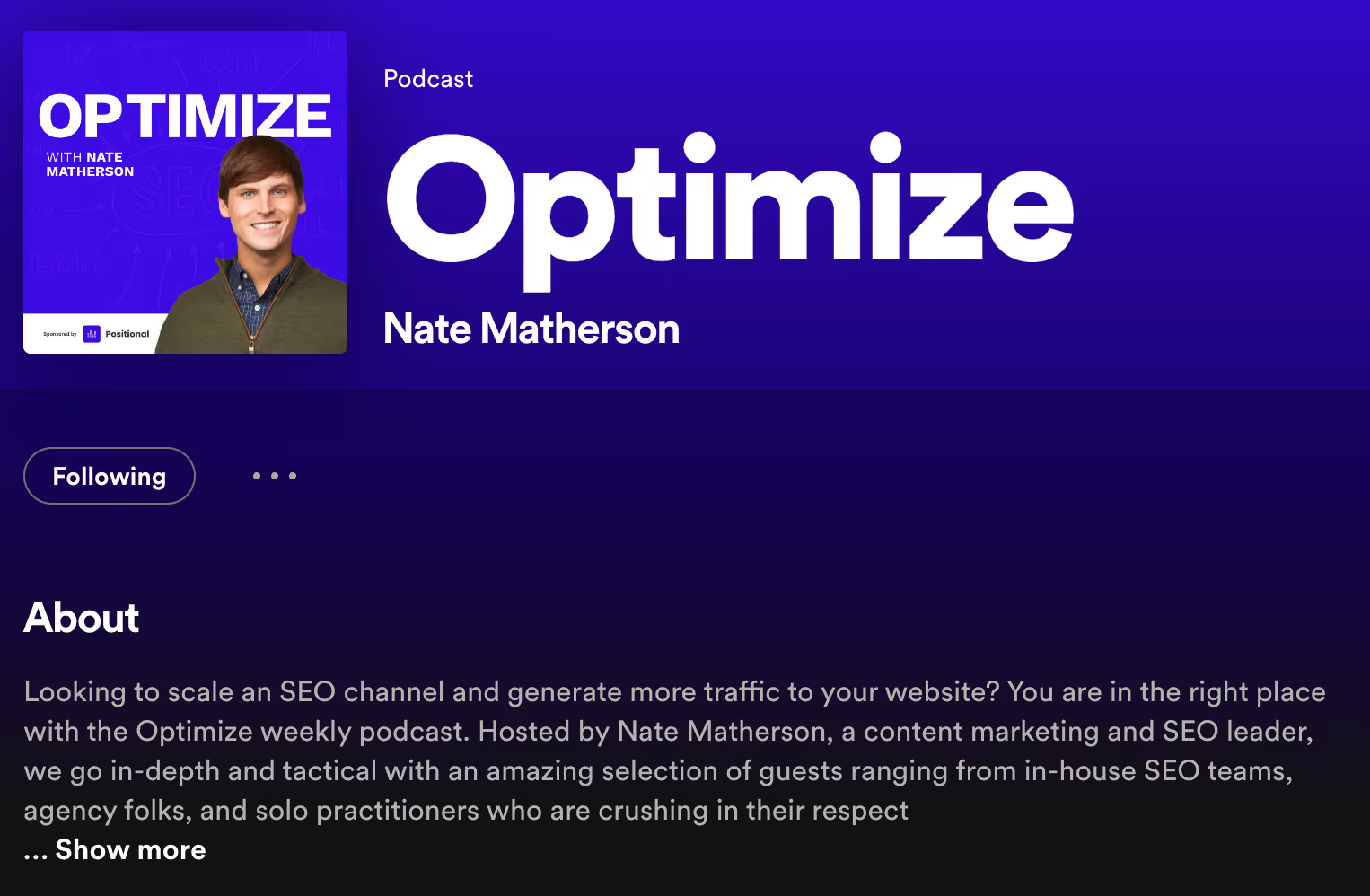
Given how dynamic the content marketing and SEO industry is, there’s really always something new for us to chat about. We work to bring on guests from a variety of backgrounds, including people who work on in-house teams, agency folks, and solo practitioners building their own websites.
On our podcast, we’ve tried to be very non-promotional about our product and service, but we do sprinkle a handful of dedicated advertisements for our product throughout the episodes.
Companies large and small are starting podcasts to reach their buyers. For example, Salesforce, a leader in CRM, has a few different podcasts, including their Salesforce Admins Podcast:
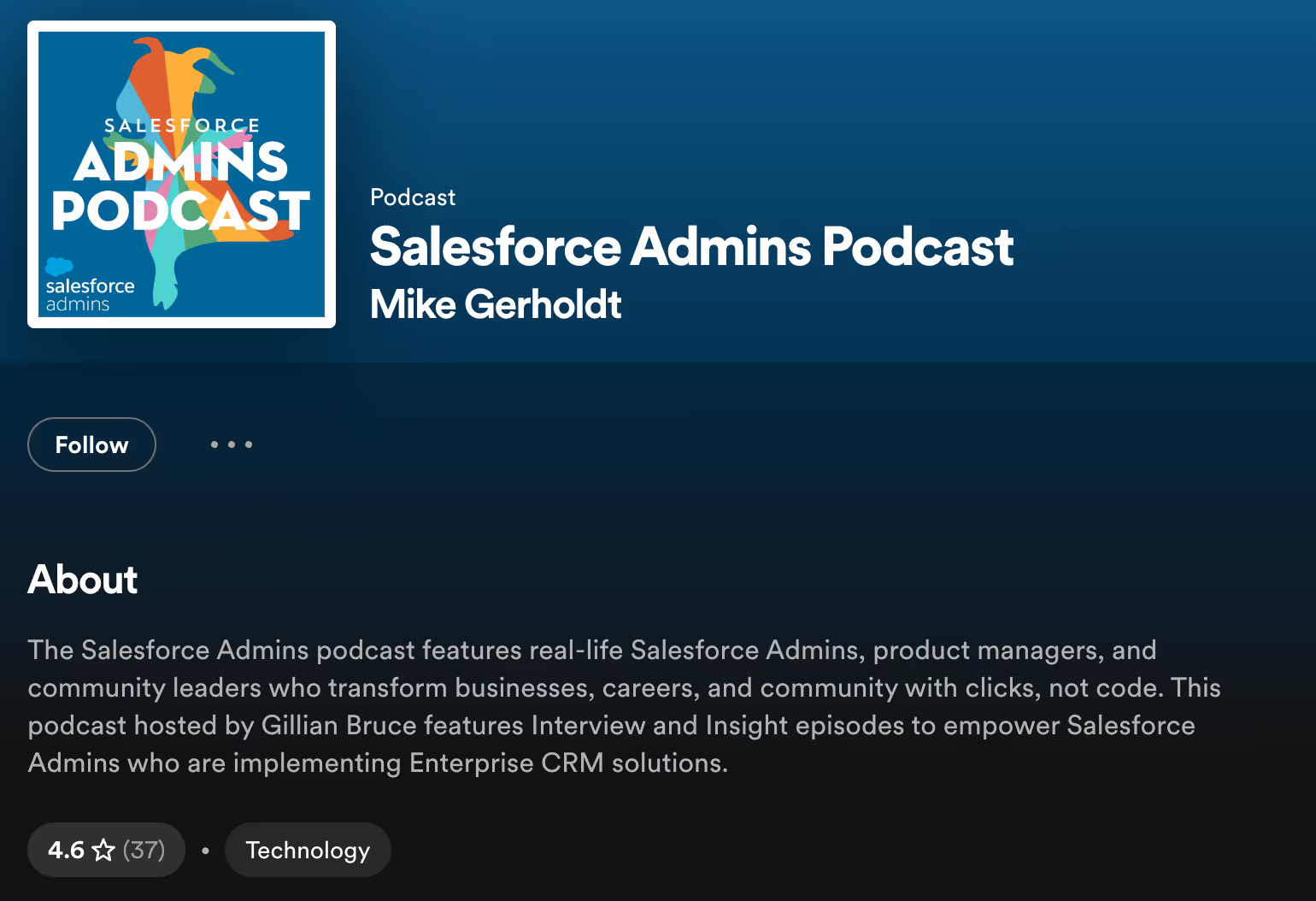
I’ve found that podcast scales a bit like SEO. It can be a slow start, but then you’ll hit inflection points where your audience starts to grow faster.
Podcasting does take a lot of time. It takes time to find the guest, prep for the conversation, edit the episodes, and then publish the podcast.
You can certainly republish excerpts from the podcast onto other channels — for example, on LinkedIn or X, or on TikTok or YouTube shorts — for additional distribution and to help build your audience.
We also regularly use excerpts and expert quotes from our podcast in our blog posts, as we’ve done in this piece of content.
6. YouTube & Video Content
YouTube is not just for your average consumer. Companies like Datadog, a leader in observability and monitoring, often have extensive video libraries hosted on YouTube.
Datadog has published hundreds of videos, including videos targeting evergreen topics and keywords like “cloud cost management”:
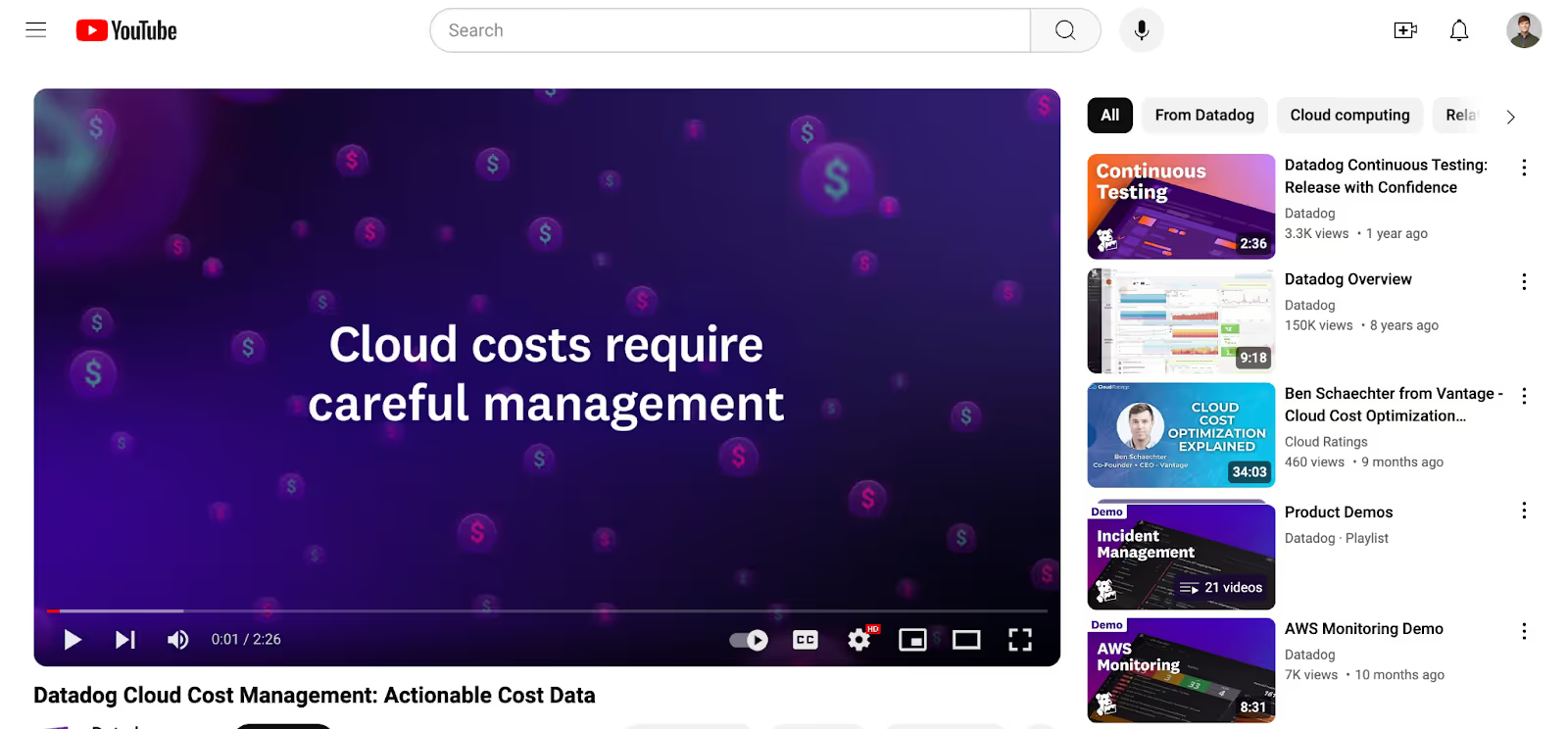
Videos like this can be very effective, because these days, more and more searchers are using YouTube as a search engine. Moreover, these videos will often rank or appear in traditional search results and SERP features.
Datadog also has a video collection for product updates, as well as video collections called “This Month In Datadog” and “Customer Stories”:
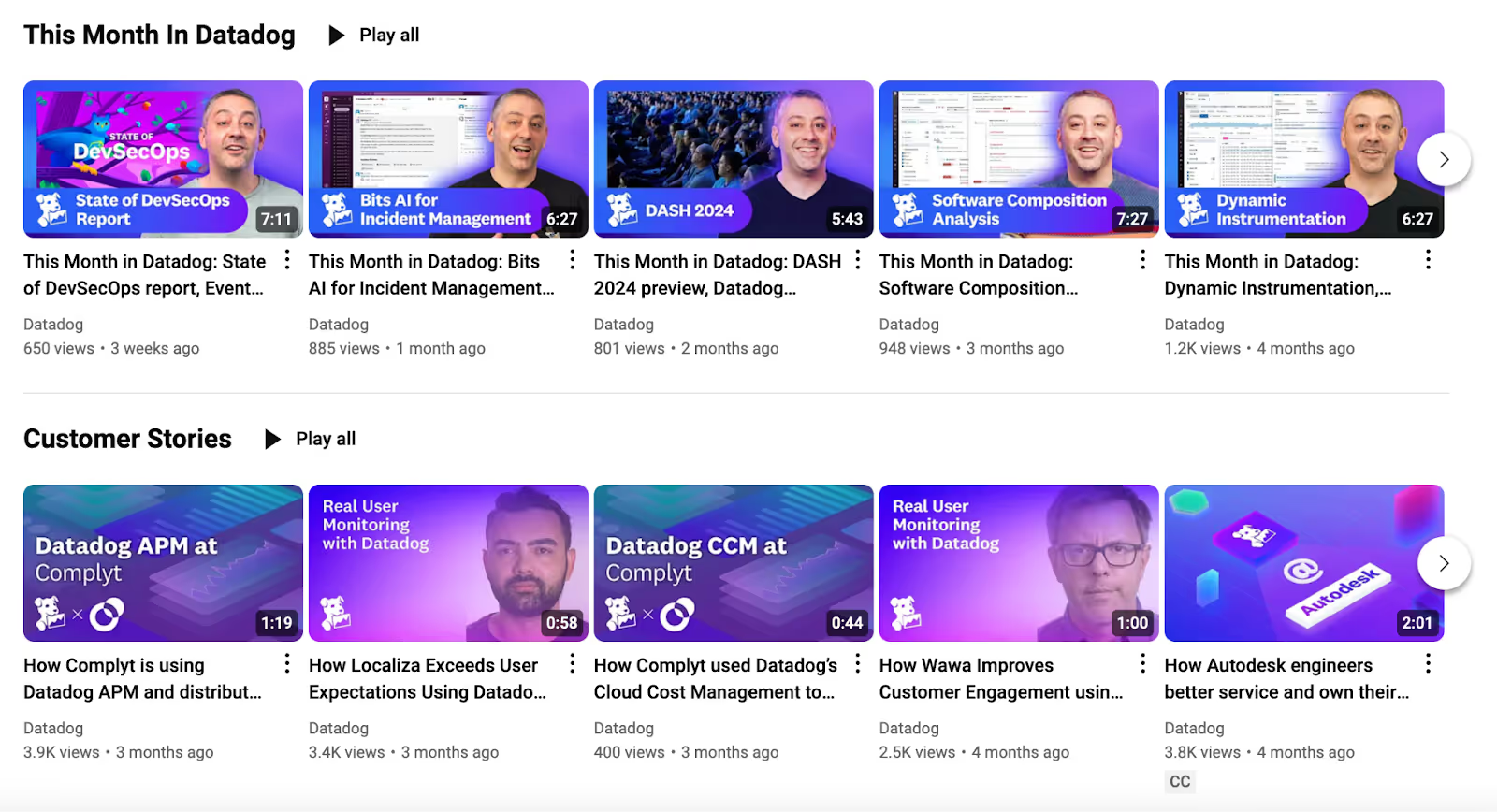
Of course, you don’t have to host your video content on YouTube. There are many other platforms — such as Vimeo, for example.
7. Short-Form Video
Did you know that 40% of Americans use TikTok as a search engine? That’s according to Adobe, which also found that 10% of Generation Zers use TikTok as their primary search engine, or more often than they use Google.
As Generation Z matures, short-term video will become an even more important channel for both B2C and B2B buyers. Eventually, those Generation Zers are going to be buying enterprise software.
Companies like Zapier, a leader in automation software, are using TikTok and short-form video to reach that next generation of buyers and builders:

They’ve amassed more than 80,000 followers on the platform, and some of their videos have more than one million views.
YouTube Shorts is another platform to consider for short-form videos.
If you’re already creating longer-form content for a platform like YouTube, consider repurposing that content into shorter clips on another platform. Moreover, if you’re creating podcast or webinar content, you might have success reaching a new audience by cutting up the key insights into shorter videos.
8. Newsletters
Newsletters are a fantastic way to keep your audience engaged and to nurture prospects through the sales funnel. And if you’re already creating content for a blog or podcast, newsletters are great for distributing that content.
At Positional, we send a weekly newsletter that includes our recently published blog posts and our most recent podcast episode. It goes out automatically every Friday — simply pulling content from our RSS feeds into MailChimp. It’s very lightweight for us and requires very little ongoing maintenance.
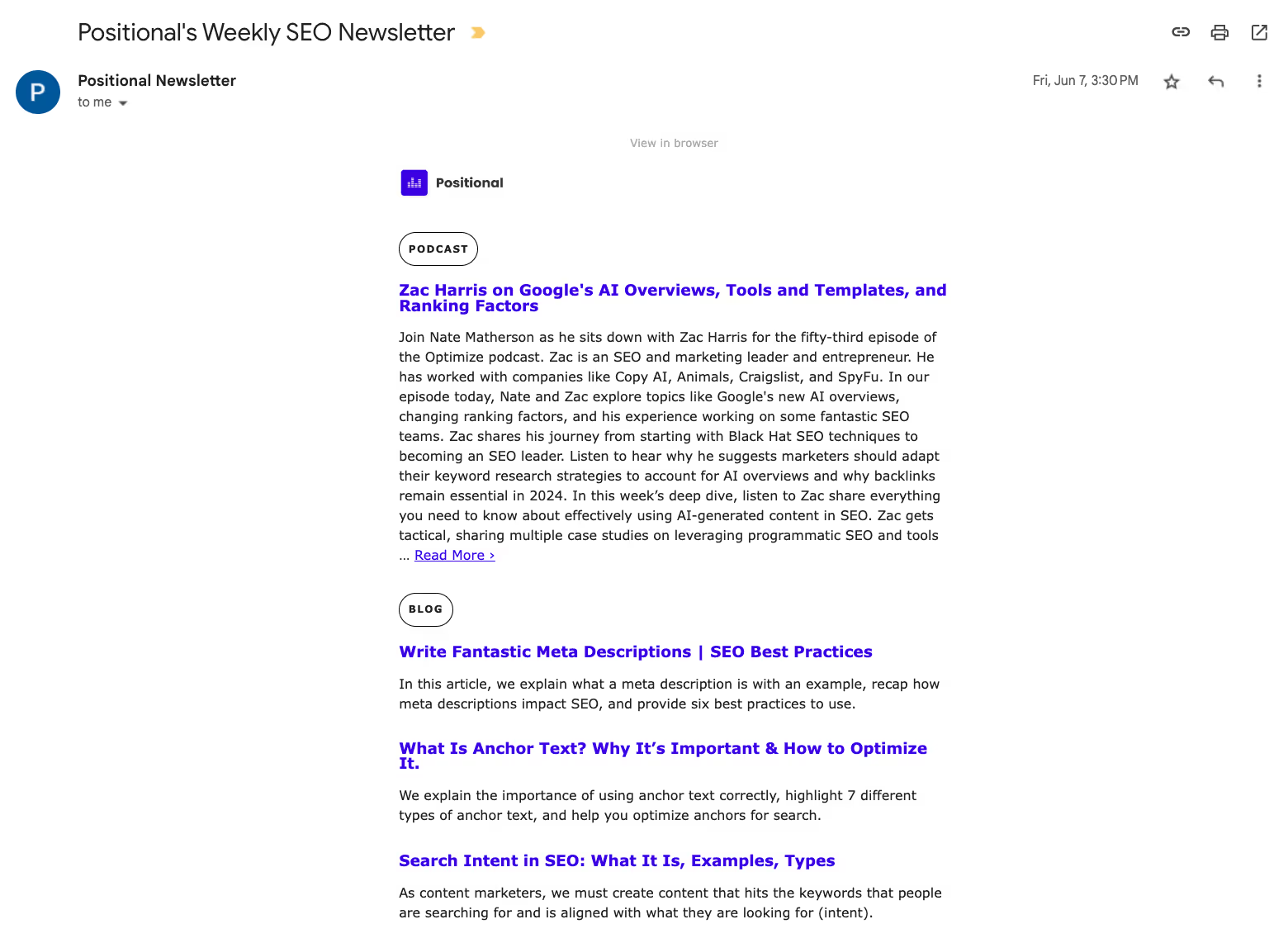
However, you can certainly put in a little bit more effort once the size of your audience grows. For example, the Core Updates newsletter is a weekly SEO newsletter that surfaces news and commentary for SEO professionals.

The newsletter is run by Mark Williams-Cook, Digital Marketing Director at Candor, a content marketing and SEO agency.
With newsletters, you have a few options. You can simply repurpose your existing content into the newsletter, you can share content from other sources online, or you can do a hybrid of the two.
9. Tools
We mentioned earlier that blog posts can be used to target specific keywords as part of an SEO strategy. But SEO often means more than just creating blog content — there are so many other types of webpages that you can create, including tools and quizzes.
Ramp, a leader in expense management and corporate cards, has created a number of really helpful tools that they integrate into their webpage content. For example, Ramp has a mission statement generator that can be used to generate a mission statement quickly:

For Ramp, a company largely targeting startups and emerging companies, this makes complete sense, because when a new company is looking to generate a mission statement, they’re likely also in the target market for Ramp’s core products.
Ramp has a number of other tools, including a burn rate calculator, a unit economics modeling tool, and an investor database.
These tools certainly help increase engagement on these webpages and improve top-of-funnel conversion, and they’re likely to accumulate backlinks, too.
10. Webinars
Webinars can be a fantastic way to engage with sales prospects and answer their questions. They’re also helpful for retaining existing customers.
Upflow, a company that helps businesses collect on overdue invoices, has done a number of webinars on topics important to their potential customers.
For example, Upflow recently did a webinar highlighting different strategies for extending your cash runway.

Naturally, collecting on overdue invoices is one way to extend your cash runway.
I really like how Upflow included Jason Lopez from Lattice in this webinar, as Lattice is one of Upflow’s customers. Bringing your existing customers onto a webinar both builds a stronger relationship with those customers and provides social proof to new customers who might be engaging with you for the first time.
Of course, you can distribute these webinars everywhere you’d expect — for instance, on LinkedIn or YouTube. You can also host recorded copies of the webinars on your website, using them as top-of-funnel content, as Upflow has done here.
11. Case Studies
Often a requirement for enterprise buyers, case studies are essential for many B2B companies.
Companies like Zendesk, a software company that offers chat and support solutions, create case studies designed to appeal to different types of buyers at different stages:
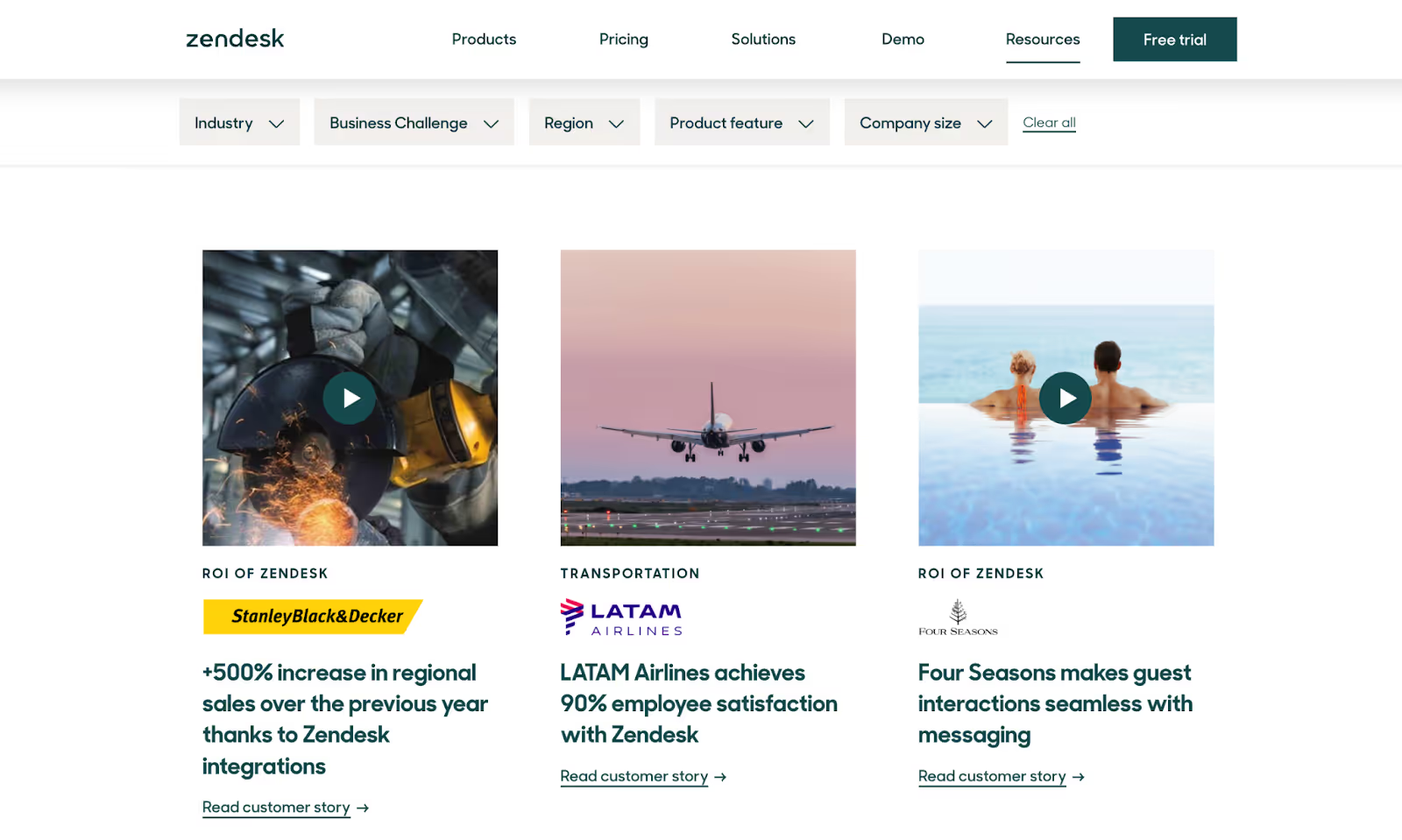
For example, Zendesk has case studies that highlight how Zendesk has helped increase sales, improve employee satisfaction, and enhance customer experience.
Case studies can be repurposed for many channels and often make for great calls-to-action once someone has landed on your website. For companies with sales-led motions, case studies can support the buyer when they need to get a purchase approved by management.
Measuring Success
While there are many different types of content marketing, one thing they have in common is that it’s often fairly hard to know whether they’re working.
Of course, you can track a number of different metrics and KPIs throughout the different stages of the funnel.
For example, if you’re just getting started with SEO, an initial KPI to track might be the number of visitors to your company’s blog. But as the size of your website grows, the most important KPI will eventually shift from website visitors to conversions, or revenue.
As another example, if you’re creating content on LinkedIn, you might be tracking the number of impressions or followers to a specific account.
If your company has a more nuanced enterprise sales motion, you could track the number of times a piece of content was used in the sales process, or when content assisted with a sale. For instance, a blog post may have resulted in a lead at the top of the funnel, or a case study may have been used in a proposal for a prospect who was further along in the funnel.
With all of these types of content marketing, it often takes time for the strategy to develop. It takes time to create the content, but it also often takes time to scale on the platform you’re distributing that content on — for example, Google Search or Spotify.
Final Thoughts
Content marketing is such a powerful strategy for B2B companies. And there are so many different formats, channels, and tactics to experiment with.
Platforms like TikTok or X might be a great fit if you’re trying to reach an entirely new audience. If you’re engaging with an existing audience or looking to move buyers throughout the sales process, then webinars, podcasts, and newsletters might do just that. And if you want to target keywords specifically at just the right time, blog content and tools designed to rank well in search engines might be calling your name.
All of these tactics work well together. You can often repurpose content from one channel to another.
Building an audience, ranking well in search engines, and ultimately driving conversions from content marketing takes time. Initially, you should set goals or measure success with leading indicators — for example, the number of followers you have on a platform or the number of impressions each piece of content gets.
%20B2B%20Content%20Marketing.avif)




